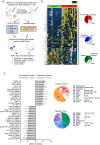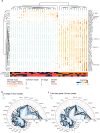Cellular and secretome profiling uncover immunological biomarkers in the prognosis of renal cell carcinoma patients
- PMID: 40126183
- PMCID: PMC11934188
- DOI: 10.1080/2162402X.2025.2481109
Cellular and secretome profiling uncover immunological biomarkers in the prognosis of renal cell carcinoma patients
Abstract
Renal cell carcinoma (RCC) is recognized as an immunogenic tumor, yet tumor-infiltrating lymphocytes often exhibit diminished effector function. However, the mechanisms underlying reduced T and NK cell activity in RCC remain unclear. Here, we examined the immune contexture in RCC patients undergoing nephrectomy to identify immune-related biomarkers associated with disease progression. Immune cell phenotypes and secretion profiles were assessed using flow cytometry and Luminex multiplex analysis. Supervised multivariate analysis revealed several changes of which frequencies of T and NK cells expressing CCR5, CXCR3, and PD-1 were elevated within tumors compared with peripheral blood. In addition, higher levels of regulatory T cells, PD-1+, and CXCR3+ T and NK cells were observed in patients with relapse following nephrectomy. With regards to soluble factors, tumor-derived CXCL8 was associated with higher Fuhrman grade and increased frequency of polymorphonuclear myeloid-derived suppressor cells (PMN-MDSCs). These biomarkers demonstrate potential relevance in the progression of RCC and merit further investigation in prospective studies.
Keywords: Biomarkers; CXCL8; NK cells; PD-1; T cells; prognosis; renal cell carcinoma.
Conflict of interest statement
No potential conflict of interest was reported by the authors.
Figures





References
-
- Dabestani S, Beisland C, Stewart GD, Bensalah K, Gudmundsson E, Lam TB, Gietzmann W, Zakikhani P, Marconi L, Fernandéz-Pello S, et al. Intensive imaging-based follow-up of surgically treated localised renal cell carcinoma does not improve post-recurrence survival: results from a European multicentre database (RECUR). Eur Urol. 2019;75(2):261–12. doi: 10.1016/j.eururo.2018.10.007. - DOI - PubMed
MeSH terms
Substances
LinkOut - more resources
Full Text Sources
Medical
